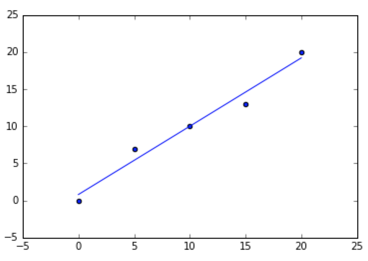You can use numpy's polyfit. I use the following (you can safely remove the bit about coefficient of determination and error bounds, I just think it looks nice):
#!/usr/bin/python3
import numpy as np
import matplotlib.pyplot as plt
import csv
with open("example.csv", "r") as f:
data = [row for row in csv.reader(f)]
xd = [float(row[0]) for row in data]
yd = [float(row[1]) for row in data]
# sort the data
reorder = sorted(range(len(xd)), key = lambda ii: xd[ii])
xd = [xd[ii] for ii in reorder]
yd = [yd[ii] for ii in reorder]
# make the scatter plot
plt.scatter(xd, yd, s=30, alpha=0.15, marker='o')
# determine best fit line
par = np.polyfit(xd, yd, 1, full=True)
slope=par[0][0]
intercept=par[0][1]
xl = [min(xd), max(xd)]
yl = [slope*xx + intercept for xx in xl]
# coefficient of determination, plot text
variance = np.var(yd)
residuals = np.var([(slope*xx + intercept - yy) for xx,yy in zip(xd,yd)])
Rsqr = np.round(1-residuals/variance, decimals=2)
plt.text(.9*max(xd)+.1*min(xd),.9*max(yd)+.1*min(yd),'$R^2 = %0.2f$'% Rsqr, fontsize=30)
plt.xlabel("X Description")
plt.ylabel("Y Description")
# error bounds
yerr = [abs(slope*xx + intercept - yy) for xx,yy in zip(xd,yd)]
par = np.polyfit(xd, yerr, 2, full=True)
yerrUpper = [(xx*slope+intercept)+(par[0][0]*xx**2 + par[0][1]*xx + par[0][2]) for xx,yy in zip(xd,yd)]
yerrLower = [(xx*slope+intercept)-(par[0][0]*xx**2 + par[0][1]*xx + par[0][2]) for xx,yy in zip(xd,yd)]
plt.plot(xl, yl, '-r')
plt.plot(xd, yerrLower, '--r')
plt.plot(xd, yerrUpper, '--r')
plt.show()


polyfitfunction and describe how it didn't work? Remember to set thedegparameter to1in order to get a linear fit. (See docs here.) – Fowling